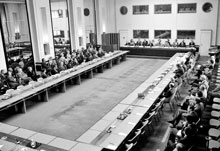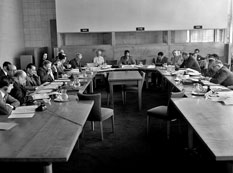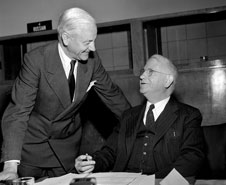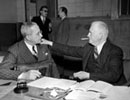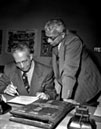|
Statute of the International Law Commission
New York, 21 November 1947
By Sir Michael Wood
Member of the International Law Commission Senior Fellow of the Lauterpacht Centre for International Law, University of Cambridge
The International Law Commission is a subsidiary organ of the United Nations General Assembly, whose object is the promotion of the progressive development of international law and its codification. The Commission is governed by a Statute annexed to General Assembly resolution 174 (II) of 21 November 1947 (as amended). In addition to setting out the structure and working methods of the Commission, the Statute is of interest for what it tells us about the divided attitudes, in 1947, towards the codification and progressive development of international law. Notwithstanding the divisions of the time – perhaps even because of the somewhat awkward compromises in the text, the Statute of the International Law Commission has proven to be a far-sighted and flexible document, which has stood the test of time. The movement to codify international law had its origins in ad hoc conferences (e.g., Vienna 1814-1815, Paris 1856, The Hague 1899/1907, London Naval Conference 1908-1909) and private ventures (Institut de Droit International and International Law Association, both established in 1873; Harvard Research in International Law, published 1929-1939). To a degree stimulated by the need for clarity in the law if the jurisdiction of the newly established Permanent Court of International Justice were to be accepted, the League of Nations engaged in more systematic intergovernmental efforts, culminating in the work of the Committee of Experts for the Progressive Codification of International Law (1924) and the 1930 Hague Codification Conference and its Preparatory Committee, but these were not a great success. In 1931, the League Assembly adopted a resolution on the procedure of codification, the underlying theme of which was strengthening the role of Governments in the codification process. Many of its ideas were included in the Statute of the Commission.
The Statute, being annexed to a resolution of the General Assembly, does not have the status of a treaty, and may be amended by a subsequent resolution of the General Assembly. Yet it has remained largely unchanged for over 60 years. It has been amended by six resolutions of the General Assembly (in 1950, 1955, 1956, 1961 and 1981), chiefly as regards the membership of the Commission, the term of office of the members, and where they meet. At the request of the General Assembly, the Commission briefly reviewed its Statute in 1951, but essentially confined itself to recommending that it be put on a full-time basis. This recommendation was not adopted by the Assembly, and in 1952 the Commission decided that it would not be opportune to proceed further with the review. In 1996, in the course of a general review of its programme, procedures and working methods, the Commission noted that the Statute had never been the subject of a thorough review and revision, but concluded that, on the whole, the Statute had been flexible enough to allow modifications in practice (Report of the International Law Commission on the work of its forty-eighth session, 1996, paras. 241-243). On that occasion, the Commission drew attention to some aspects of the Statute which warranted review and revision (in particular, what it described as the “unworkable” distinction between progressive development and codification, where it suggested that “the procedure for both should be expressly assimilated”). The Commission recommended that it give thought to the possibility of recommending to the General Assembly a review of the Statute, but this was not followed up. Presumably States did not consider the anomalies in the Statute sufficiently serious to warrant opening up the text to general review. The Commission’s current working methods are not readily apparent from the Statute, which needs to be read in light of the practice of the Commission and General Assembly as it has evolved since 1947. While the Statute does establish the basic framework for the organization of the Commission, its working methods, and indicates the outcomes of its work, it has not acted as a straitjacket. But it nevertheless remains the starting point for an understanding of the Commission. After a first article setting out the object of the Commission, the Statute is divided into three chapters. Chapter 1 (articles 2 to 14) concerns the organization of the Commission. Chapter 2 (articles 15 to 24) describes its functions. Chapter 3 (articles 25 and 26) deals with cooperation with other bodies. Article 1, reflecting Article 13, paragraph 1 (a), of the Charter, provides that the object of the Commission is “the promotion of the progressive development of international law and its codification.” It further provides that “[t]he Commission shall concern itself primarily with public international law, but is not precluded from entering the field of private international law”. The Commission has not in fact concerned itself with private international law, except incidentally as part of its consideration of questions of public international law (such as in connection with the topic Jurisdictional immunities of States and their property). Chapter 1 deals with the Commission’s composition, the procedures for the nomination of candidates and their election, the term of office of members (initially envisaged as three, but extended to five years as early as 1950), payments to be made to them (which continues to be a controversial matter), and where the Commission should meet. The Statute originally provided that the Commission should sit in New York, but this was changed to Geneva in 1955, given the view of the Commission that conditions at the European office of the United Nations are more conducive to efficiency in the kind of work the members of the Commission have to perform. Indeed, after its first session, the Commission has almost always met in Geneva. Initially the Commission had fifteen members. This increased to twenty-one in 1956, twenty-five in 1961, and thirty-four in 1981. The members of the Commission are to be “persons of recognized competence in international law” (article 2). It is implicit in the text of the Statute, and clear from the negotiating history and subsequent practice, that they serve in their individual capacity, not as representatives of States.
The Statute requires the Secretary-General, so far as he is able, to make staff and facilities available to the Commission. The Codification Division of the Office of Legal Affairs has, from the very beginning, made an important substantive contribution to the Commission’s work, not least by preparing or commissioning studies both of a general nature and on individual topics on the Commission’s agenda. The fact that the members of the Commission are not full-time has made the Division’s contribution even more vital. Successive Directors of the Codification Division have acted as Secretary to the Commission. Chapter 2, entitled “Functions of the International Law Commission”, commences with an article describing, for the purposes of the Statute, “progressive development of international law” and “codification of international law” (article 15). “Progressive development” means “the preparation of draft conventions on subjects which have not yet been regulated by international law or in regard to which the law has not yet been sufficiently developed in the practice of States.” “Codification” means “the more precise formulation and systematization of rules of international law in fields where there already has been extensive State practice, precedent and doctrine.” The chapter then sets out separate procedures for progressive development (Part A) and codification (Part B). Part A further distinguishes between (i) cases where the General Assembly refers to the Commission a proposal for the progressive development of international law (article 16); and (ii) cases where proposals and draft multilateral conventions are submitted by Members of the United Nations, principal organs other than the General Assembly, specialized agencies, or “official bodies established by intergovernmental agreement to encourage the progressive development of international law and its codification” (article 17). Part B sets out a single procedure for codification. This includes an important provision listing a range of possible outcomes to the Commission’s work, a provision that in practice seems equally appropriate for topics involving progressive development of the law. The Commission may recommend to the General Assembly (a) to take no action, the report having been published; (b) to take note of or adopt the report; (c) to recommend the draft to Members of the United Nations with a view to the conclusion of a convention; or (d) to convoke a conference to conclude a convention (article 23). It quickly became apparent that the Statute’s distinction between progressive development and codification, with three separate procedures, was not workable in practice. According to Briggs (The International Law Commission, p. 141), “[i]t was foreseen from the outset that the distinction was basically and practically unsound, but political considerations had dictated its incorporation in the Statute.” In practice, the Commission has developed what is essentially a single, albeit flexible procedure, for handling all main topics, drawing on the main features of the procedures in the Statute. These include a deliberate progression through a first and second reading, taking full account of the importance of consulting States throughout the process, individually and within the Sixth Committee. Part B contains two provisions of wider interest. Article 18 required the Commission to “survey the whole field of international law with a view to selecting topics for codification”, with a view to selecting those whose codification is “necessary and desirable”. This led to Hersch Lauterpacht’s celebrated “survey of international law”, which (together with a 1971 survey) was the main inspiration for the Commission’s work for almost fifty years. Since 1992, the Working Group on the Long-term Programme of Work of the Commission has been identifying the topics for possible future consideration by the Commission on the basis of outlines or summaries of pre-selected topics prepared by members of the Commission, or its Secretariat. On that basis, the Working Group regularly recommends a list of topics to be included in the long-term programme of work of the Commission. This list now guides the Commission in the selection of topics. Under article 24, the Commission was to “consider ways and means for making the evidence of customary international law more readily available, such as the collection and publication of documents concerning State practice and of decisions of national and international courts on questions of international law”. Part II of the Commission’s 1950 report to the General Assembly led to a series of important publications, international and domestic, official and non-official, which continue today, including the United Nations Juridical Yearbook, the United Nations Legislative Series, the Repertory of Practice of United Nations Organs, and the Reports of International Arbitral Awards. Chapter 3 makes provision for the Commission to consult widely, with any United Nations organ, and with “any international or national organizations, official or non-official” (articles 25 and 26). (Articles 16 and 21 also refer to consultations with scientific institutions and individual experts.) The trend towards greater consultation seems likely to continue, especially as the Commission takes up new emerging topics. The Commission has recently held consultations with outside experts on such topics as Shared natural resources, Responsibility of international organizations, and Protection of persons in the event of disasters. For an instrument drafted in 1947, the Statute displays a remarkable openness to consultations, both with Governments and with non-governmental bodies and experts. This Introductory Note was written in November 2008.
Related Materials
Under Article 13, paragraph 1(a), of the Charter of the United Nations, the General Assembly shall initiate studies and make recommendations for the purpose of encouraging the progressive development of international law and its codification. With a view to implement its obligations under this provision, the General Assembly adopted, on 11 December 1946, resolution 94 (I), establishing the Committee on the Progressive Development of International Law and its Codification, consisting of seventeen Member States. The Committee was directed to study the methods by which the General Assembly should encourage the development of international law, the methods of securing the co-operation of the several organs of the United Nations and the assistance of national or international bodies as might aid in the attainment of this objective. The Committee met from 12 May to 17 June 1947 and submitted a report to the General Assembly recommending the establishment of an International Law Commission and setting forth provisions to serve as the basis for its statute (A/331).
In accordance with the relevant provisions of its Statute, the first elections to the International Law Commission took place on 2 November 1948, and the Commission opened the first of its annual sessions on 12 April 1949. (For more information on the sessions of the International Law Commission, see http://www.un.org/law/ilc/).
Text of the Statute Selected preparatory documents League of Nations, Assembly resolution of 25 September 1931: Records of the Twelfth Assembly, Plenary Meetings, p. 135.
|


